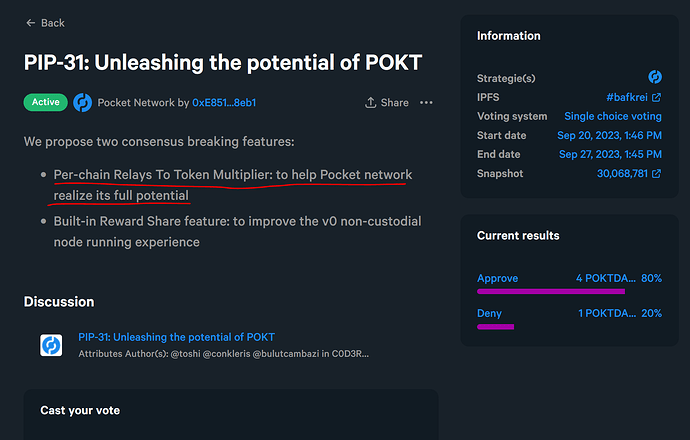If we are talking about rewards per chain, then we have to talk about rewards per chain as a whole. Trying to limit the conversation about rewards per chain to only talking about RTTMs and ignoring MaxChains is like trying to fix a broken engine with new tires.
Farther down in your comment, you again say ![]()
Again, you believe that this is a means to achieve proper incentive per chain “without GANDALF”. Clearly GANDALF is related, and this is being suggested as an alternative, so trying to separate them is impossible.
I don’t disagree with the per chain RTTM concept and have supported it in the past. The issue is you are trying to introduce it into a system that is rigged to only benefit the larger providers. It akin to trying establish “equality” into a system that at it’s foundation is rigged for those with infrastructure power.
Seeing that the principle of equality is part of your motives here, then I invite you to first join in fixing a more foundational root issue that has crushed the little guy, which is MaxChains. Instead of the DAO figuring out the “right per-chain incentive”, we de-rig the system from requiring someone to run 15 chains to get network average. Make it so anyone with a chain node can participate in POKT, instead of requiring them run 14 other chains as well. It is a no-brainer for those who want little guys to re-join the POKT ecosystem.
You are mistaken in believing that RTTM per chain will have meaningful impact on the little guy. If we look at the data today, by doubling archival chains, as you have suggested, for a chain like BSCA it would generate a whopping $.26c more per month for each of the 745 servicers. This means that someone is supposed to run a BSCA for $.52c per month. This means that BSCA as a whole generates $391.87 which is spread across a few node runners.
According to the numbers though, larger enterprises like yourself would benefit the most. By doubling ETH Archival Tracing it would go from $482.75 to $965.50, and since c0d3r has the majority of ETH Archival Tracing, most of that $482.75 would go to you. Those with larger amount amounts of node, like yourself, would objectively benefit the most… so it is a misunderstanding to suggest it benefits the little guys.
Benefit The Little Guy
Instead of increasing the rewards for archival chains by a few cents each month, reducing MaxChains would reduce the cost of infrastructure for small node runners by hundreds or thousands of dollars.
Example: Take a node runner with 10 POKT nodes. What would be better?
- Increasing the monthly reward for BSCA from
$.26cto$.52cper month (while still requiring them to run 14 other chains) - Allow them to generate full rewards on 1 chain, and save
$100sby shutting down infra for 14 chains.
Objectively #2 is better. If you were to first Reduce MaxChains to 1, then double rewards with dynamic RTTM, and the reward bump would be more meaninful $11.50 to $23.
When it comes to the principle of meaningfully bring equality to node running, everything objectively first starts with MaxChains.
Again, I agree with the notion, but we are again trying to put the cart before the horse. You want to start preparing POKT for “more than serving blockchain RPC”, but that can’t happen until there is balance. You mention using POKT for AI API calls… that is awesome, but someone running the AI would also have to run 14 chain nodes. Nothing makes sense until someone can participate in POKT with 1 data source.
Yes, let’s prepare for AI API, by making it possible to run 1 data source per node (not 15), then we can balance out the rewards per source. I would be happy to work with you to make this happen.
I don’t agree this is the best tatical move. If you want to add new chains, and enable chain adoption, then the best thing to do would be to allow the ABC chain community to join POKT and generate meaningful rewards by serving only ABC requests on POKT. The way you are looking at creates incentive for existing providers, like yourself, to run unprofitable chains. In reality though, for a new chain like ABC, there are likely folks in that community that already run ABC nodes and would join POKT to further monetize their existing nodes.
When we first started adding new chains, this marketing strategy worked. POKT had multiple marketing opportunities directly with foundations (like AVAX and BSC) to promote their chain launch on POKT and encouraging their community to monetize their nodes on POKT. It worked in the past and could easily work again for new chain if POKT was back to being a way for anyone to generate meaningful rewards from a SINGLE data source.
Etherum’s mining wasn’t structured so that you had to have 15 video cards to generate average rewards per hash power… you just needed 1. POKT is fundamentally backwards from every other project in crypto.
The system is currently rigged so that only those with the infra to support 15 chains can generate network average rewards. Trying to address these issues with per chain RTTM doesn’t address any core problems, but instead makes it so that those with the most influence over the DAO would benefit the most from per chain weighting. You still have not addressed how this would NOT lead to bureaucracy mayhem.
